The key to getting free traffic from search engines is keyword research. Neglecting keyword research is short-sighted and dopey. Who would voluntarily pass on free traffic if all it takes is a couple of minutes browsing the internet? So here is your guide to keyword research for bloggers: find keywords and phrases your audience uses and that you can rank for.
Let me make this clear from the start: I am not an SEO specialist. I am totally aware that SEO includes a lot more than keyword research. However, I have picked up one or two tricks during my blogging journey to help my content get search traffic.
I am not a fan of content for search engines. I create content for my audience and I want to keep it that way.
But even content you create with value for your audience in mind, can earn some traffic from search engines if you know some SEO basics and do it right.
Keyword research is an essential part of content creation!
It all starts with finding keywords that you can rank for.
Writing blog content in one of the most competitive niches on the Internet (Marketing and Blogging), I can proudly say that I don’t get traffic from search engines through luck and chance. It is about understanding how it works, knowledge, and a process that works even in my crowded niche.
In this post, I share some of my insights about keyword research and how you can give your content a fair chance of ranking even when your blog is new, does not have a significant domain authority, and you haven’t spent a couple of weeks or even months on link building.
A blogger’s guide to keyword research
This is not an SEO guide to keyword research. This is for a blogger who does not focus on traffic from search engines. Instead, this is for a blogger who writes content for their audience and still wants to have a chance of getting some traffic from search engines.
I don’t run a blog focused on search traffic. I don’t create content for SEO purposes. Instead, I write for people: You.
But that does not mean I want to miss out on the opportunity of getting traffic from Google search for free.
You can only get traffic from search engines if your content shows up in the search results for a keyword or phrase that people search for. The goal is not to just appear somewhere down the list of search results. You want your content to show between the first results Google lists for a matching keyphrase.
That means you need to figure out what people could be looking for when your content is the answer: Keyword research.
Keyword research is not all about search engines. It is also about using the words that the people looking for your content are using. It is also about figuring out what related questions people from your target audience have about this topic and what those people expect to find in that content.
Keywords give you a lot more than a chance of ranking in search. They give you ideas for questions your content should answer, they help you find subsections for your content and they show you what information about this topic is already out there for your audience to find.
Keywords help you create the best content for your audience!
Understanding SEO keywords
SEO keywords are phrases or terms people type into search engines like Google. Bloggers target these keywords in their content to improve their website’s ranking in the search results (SERPs) for those specific terms. This way, when people search for those keywords, the blogger’s content is more likely to be shown at the top of the results page.
To rank a blog post in search listings, you need to know which keywords people are looking for and then incorporate the keywords into your content. You also need to understand how much competition is there for a keyword or phrase and good your chances are to win the competition for these keywords.
Long ago in the early days of SEO, it was enough to stuff a piece of content with the keyword. I can remember a time when the keyword tool YOAST asked me to use the focus keyword in my post so often that it was annoying me – I don’t want to know how my audience liked that content ;(
Today, SEO is a lot more complicated than stuffing content with one keyword. Search engines understand more about context, content relevancy, and related searches.
The Importance of Context
Search engines are constantly striving to deliver the most relevant results to users. Context helps them understand the searcher’s intent behind a particular keyword and the relevance of a piece of content for this search intent.
But how can you make the context clear in your content? That is a question that you should not only answer for search engines but also for your audience!
Context for your audience:
Make the topic clear in the introduction: You have approximately 5 seconds to grab and hold your readers’ attention. Set the stage by introducing the topic with the right keywords. If your introduction gives the wrong impression of what your content is about you have already lost.
Define Key Terms: Use the language your audience uses. As a mathematician and as a consultant, every time I tackled a new topic (sometimes in a different language), I had to invest some effort into making sure that I got the main terminology right or I would have lost my audience, clients and sounded like an amateur where I wanted to be an expert.
Use Examples and Illustrations: Concrete examples, case studies, or visuals can significantly enhance understanding. They bring the content to life and make it easier for readers to grasp the context. They also show that YOU have experience with the topic and don’t just repeat what someone else already said.
Consider Your Audience: Tailor your writing style and level of detail to your target audience. What might be common knowledge for one group might require more explanation for another. I have to remind myself that I also write for people who are where I was 5-10 years ago. I am not always trying to educate experts, I want to help people who are trying to figure things out. My writing needs to consider this.
Context for search engines:
Strategic Keyword Placement: Don’t go overboard with the focus keyword. Include relevant keywords naturally throughout your content. Distribute your keyword through your complete text instead of mentioning it several times in the beginning and not again. Include the keyword in the title, sub-headings, and meta description.
Use Related Keywords. A slightly broader term for this is Latent Semantic Indexing (LSI – sounds very expert, right?). LSI keywords are synonyms and related terms that help search engines understand the broader context of your content. Include these related keywords organically to show a deeper understanding of the topic (and avoid the annoying repetition of one keyword over and over). Keyword research helps you do this by providing you with a complete set of related terms and phrases.
Internal Linking: This is an often neglected but very relevant task you should perform for every piece of content you publish on your website. Link to relevant content within your website that provides additional context or expands on specific points – and after publishing consider linking to your new piece of content from some of your existing content pieces. These links create a web of information on your website that search engines can crawl and help them understand the context of your content piece as well as the overall structure of your site.
Strategically placed internal links can not only provide context, they can also emphasize your most important content: Your content pillars.
Optimize Your Images: Include descriptive alt text for your images. Use relevant keywords for the imagealt texts where it makes sense. This not only improves accessibility but also provides search engines with contextual information about the visual content. It gives you an additional chance of ranking in search engines for your images.
About different types of keywords
Not all keywords are equal.
For one topic, there are very few keywords with high search volume and millions if not billions of keywords and phrases with lower search volume. Often the high-volume keywords are broader while the low-volume volume keyphrases can often be a lot more specific.
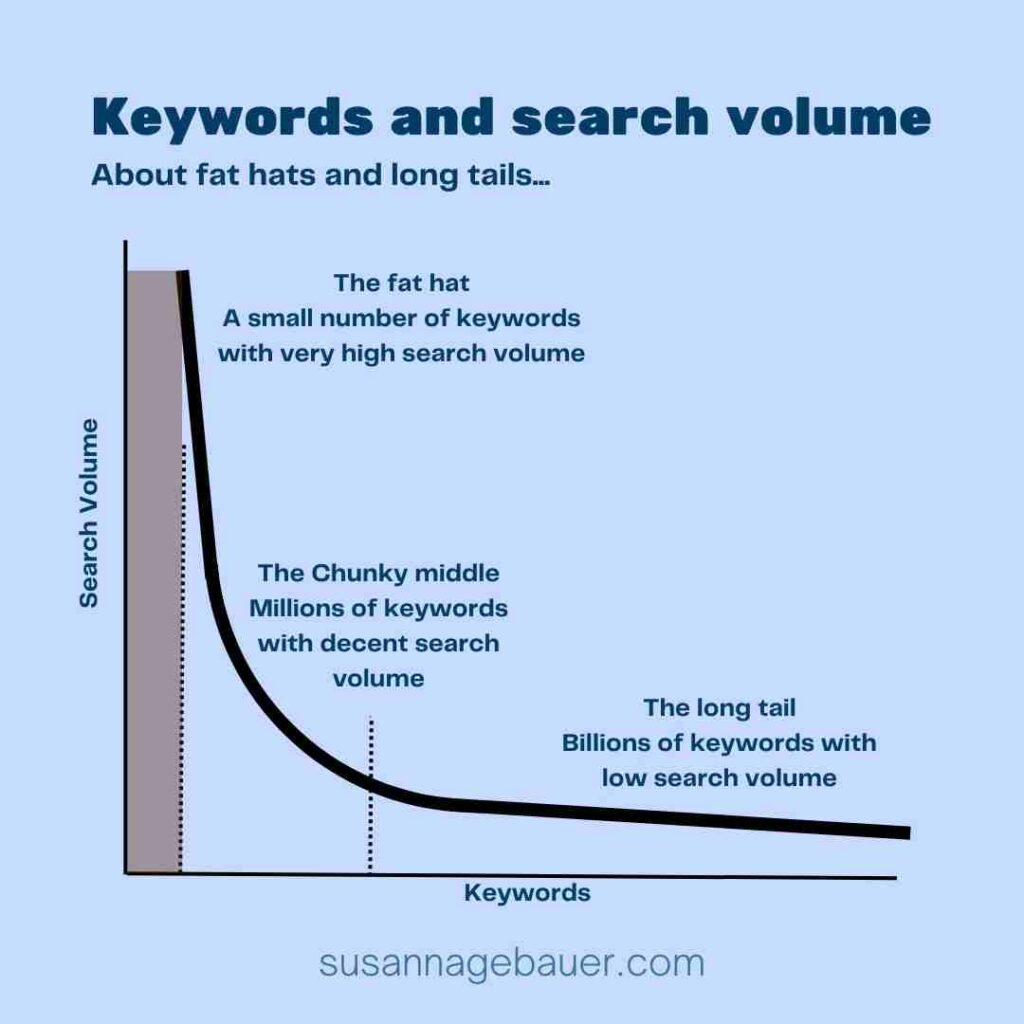
Example:
- Tomatoes: Search Volume 210,000 according to Ubersuggest
- When to plant tomatoes: Search volume 6,600 according to Ubersuggest
- When to plant tomatoes in Missouri: Search volume 480 according to Ubersuggest
The problem with trying to rank in search results is that most simple keywords with high search volume that instantly come to mind when we think about a topic are already taken. The competition to rank for these high-volume keywords is fierce. A new website has almost no chance to rank for them.
As a fresh blogger, my gut told me to search for high-volume keywords that no one thought of. And I found one: “digital marketing” was not very competitive at the time and many people searched for it. But while this keyword and the article I wrote for it (on my old blog I ran with my brother blog.thesocialms.com) brought us a decent amount of search traffic for a while, this traffic did not convert very well. People searching for this keyword often had no clue about marketing they were not ready to start their marketing journey and they were not ready to invest money into it.
But the fact that high-volume search terms are hard to rank for and don’t necessarily convert well, does not mean that you don’t have a chance to get search traffic. You just have to come to it from a different angle.
Instead of aiming to rank for keywords with high search volume that are competitive, you should try to rank for more specific phrases and keywords that are less competitive but also have fewer people searching for them.
What are longtail keywords?
When you look at the illustration of search volume vs. competition or conversion the area where more specific keyphrases with low search volume are displayed is a “long tail.” Keywords displayed here are called long tail keywords. This describes search terms of several words that describe in more detail what the searcher is looking for. Since the search terms are more specific many of them have low search volume.
There a many longtail keywords (or rather keyphrases) of several words with low search volume.
For most blog posts these long tail keywords are a much better match than the simple keywords that may have a ton of searches but only broadly describe what people are looking for.
Looking at the above keyword example for “tomatoes”: It is hard to come up with the perfect blog post for “tomatoes” that covers every topic someone could be looking for when typing the term “tomatoes.” They could be looking for such different things as:
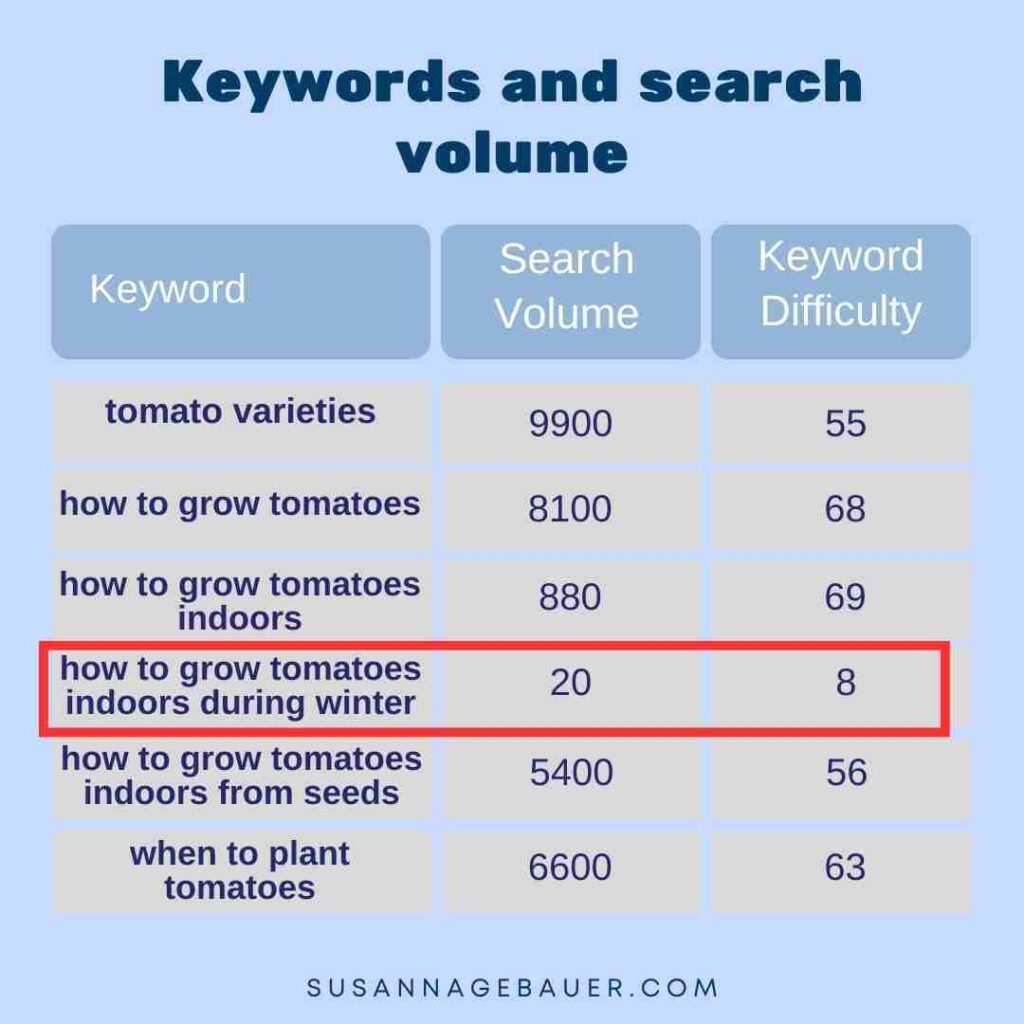
- tomato varieties
- how to grow tomatoes
- how to grow tomatoes indoors
- how to grow tomatoes indoors during winter
- how to grow tomatoes from seeds
- what colors can tomatoes have
- how to prune tomatoes
- tomato recipes
- how to store tomatoes
- when to plant tomatoes
- Italian vegetables
- Vegetables I can grow in pots
You can easily write one blog post for each of the above phrases and get a chance to rank for some of them. You can also use several long tail keyphrases in one content piece.
What you are really looking for in your keyword research are long tail keywords with low competition or keyword difficulty.
In the list of keywords the term “how to grow tomatoes indoors during winter” has a good chance to rank high as the keyword difficulty is very low (see image.)
What are shorttail keywords?
Short-tail keywords, also known as head terms, are search phrases on the opposite end of the spectrum from long-tail keywords. They are generally one to three words long and represent broad topics with high search volume.
So we are stuck between targeting high-volume, competitive and low-converting keywords and low-volume keywords that we would like to group into one blog post in a way that makes sense.
That is where related keywords come into the game.
In the above list of keywords we already focused on a couple of keywords around a similar topic. These keywords are related.
Related Keywords
Related keywords are keywords and phrases that are closely connected to the main keyword and/or each other. Your audience and search engines use related keywords to understand the context and the scope of a piece of content.
You can use related keywords to add context and value to a piece of content.
For instance, if you create a piece of content for “tomatoes”, the list of keywords
- tomato varieties
- how to grow tomatoes indoors
- how to grow tomatoes from seeds
- what colors can tomatoes have
- how to prune tomatoes
put the context of the content into the “how to grow tomatoes” angle and you can attract search traffic for all these (longtail) keywords.
However, if you use related keywords like
- peppers
- zucchini
- aubergine
The context of your content could be “Italian cuisine” or “Italian vegetables.”
Do you see how related keywords add context to content?
When you are targeting longtail keywords you are targeting a low search volume per keyword.
There are often closely related long tail phrases that you can target within one blog post. Related long-tail keywords can make for great subsections in your post. This way, you can answer many of the questions your audience has and earn an extra chance for blog traffic through additional keywords.
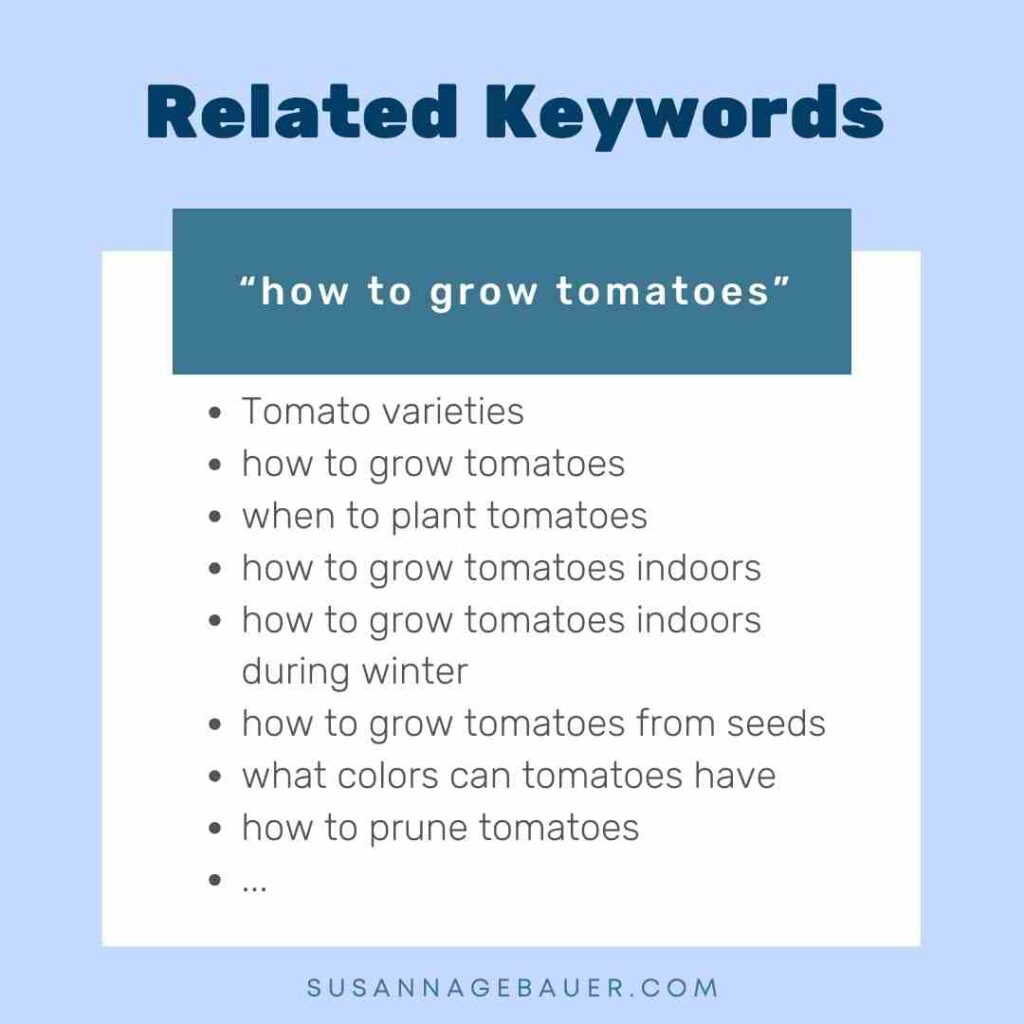
In the above tomato example, you could write a piece of content for “How to grow tomatoes in pots” and use the list of keyphrases as a starting point for your subsections. This gives you a chance to earn search traffic for each of the long-tail keywords.
A Guide to Keyword Research
So, this post is supposed to be about keyword research and so far I have talked a lot about keywords but not how you can find them (aka do research.)
The following is not a perfect keyword research process for SEO content. But it is a keyword research process that works for me and helps me fill my content ideas with keywords and relevant subsections and answer many questions people are searching for in Google!
Brainstorm relevant keywords
I usually start with a mix of idea and keyword brainstorming. If I have a vague idea for a topic I want to cover, I play around with related keywords, use tools to get an idea of how competitive the topic is, put some keywords into Google, and see what kind of results I get.
The goal is to get a feeling for the topic:
- Is there a chance to rank for it?
- What questions do people have when looking for this topic?
- What does existing content cover about this topic? Can I provide more information and value?
Then I start collecting keywords around the topic:
I start with a main keyword or rather a topic I want to cover.
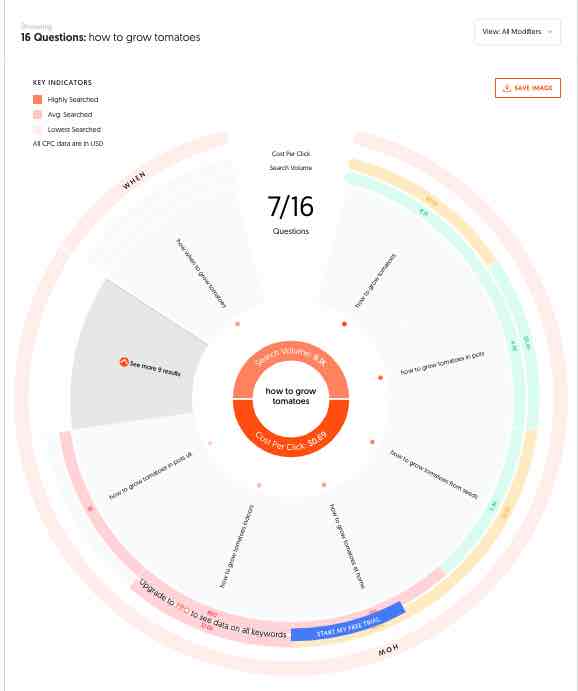
I want to know more about the keywords for this topic and use tools to get more ideas for keywords and phrases that people search for concerning the topic. Here are some ideas where you can find more keywords:
“Answer the Public”
Answer the Public is a tool that spies on the autocomplete data in Google and provides you with questions people are asking about your topic. It is an awesome starting point for your content and the audience searches you want to consider in your content.
Google search autocomplete
Although Answer the Public also uses this data, I type my topic into Google to see what autocomplete suggestions I get:
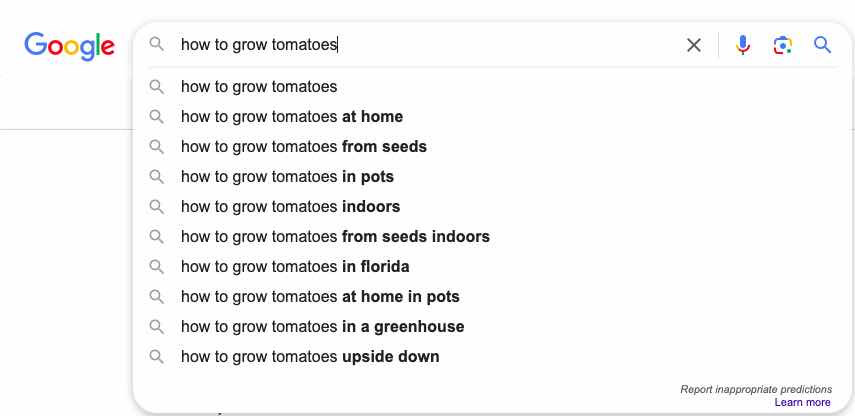
I also check the “People also ask” section and the related searches, Google gives me at the bottom of the search results listing.
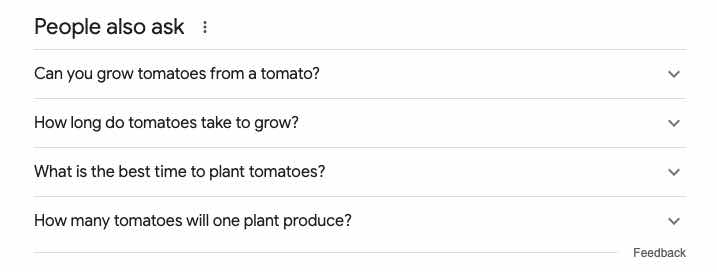
This already gives me a pretty decent list of keywords. If your keywords are still very competitive (see next section) you can repeat this for a longtail keyword and go even deeper into the longtail.
For instance, for our tomatoes, we could repeat the process with “How to grow tomatoes in pots” and check what phrases and questions come up.
Collect data about researched keywords
We now have a long list of keywords or phrases but we don’t know yet how competitive they are and how much search volume they have.
In this next step, we are using some SEO tools to collect data around our relevant searches.
I use “SEMrush,” and “Ubersuggest” to get search volume and keyword difficulty. These tools also give me more suggestions for related keywords.
Here is the result for “how to grow tomatoes” from Ubersuggest. We learn that there is a decent search volume on this topic but it is also still fairly competitive (SEO difficulty).
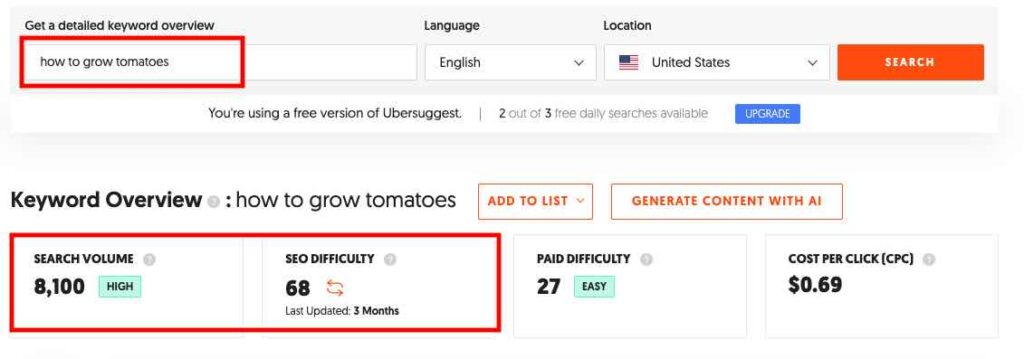
The related searches we get from Ubersuggest look like this:
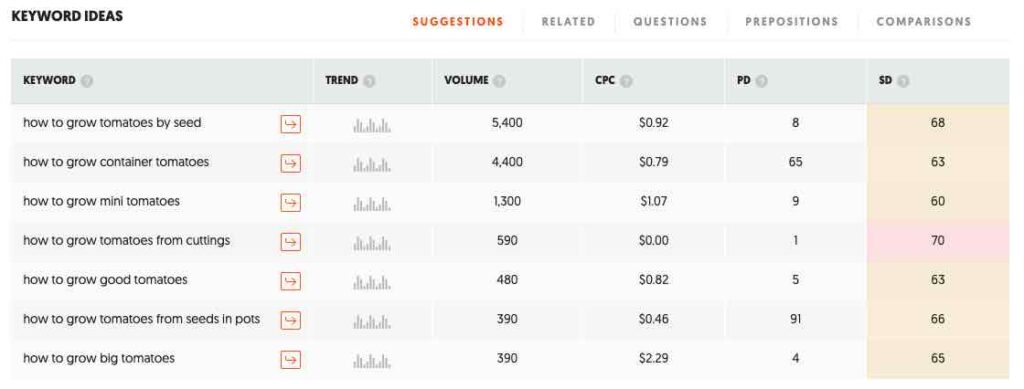
Use keyword research to decide on your topic and subsections
While I usually have decided on a broad topic before I start my keyword research, the keyword list and related keywords help me refine the topic.
How specific should my content piece be? Do I write one article or are there so many questions to answer that I should split it up into several content pieces?
- Now, I choose which of the keywords on my list I want to use in my content. Usually, some of the key phrases will make subsections in the content. I use these to draft my content outline.
- From the chosen keywords, I now select one keyword that I am going to use as the focus keyphrase for the content.
Choose keywords for your content
From your list of keywords, you now should select the ones you want to use in your content – in addition to the keywords you already chose for your subsections.
While the search volume plays a role, you should choose your keywords more from the audience and topic perspective. Use the keywords in your content that make sense and add context. Use words that your audience uses and understands. Choosing a keyword for the search volume if it is not a good match will not bring you traffic and not make your audience happy. An unhappy audience will not convert.

Why you need to do keyword research
…even if you hate SEO:
I don’t like SEO. But I like free traffic from search engines. That is why I integrate keyword research into my content creation process and do it for every blog post.
But there are more reasons why you should do keyword research:
You will learn what your audience is looking for and what you should cover in your blog post.
You learn about words and phrases your audience uses. If you speak the language your audience understands you can connect to them better and help them understand the topic.
Keyword research is not just about SEO and getting traffic from search engines. It is also about getting to know your audience and what they want to know.
Keyword research will help you create better content – and get some free traffic on top.




